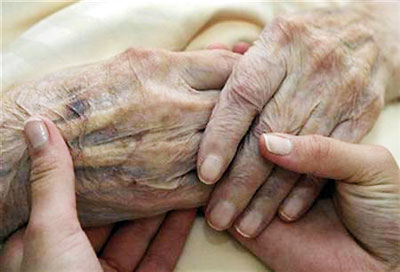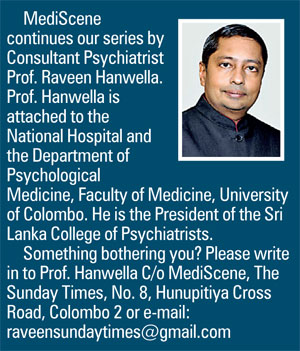Taming the last two of the Big Four
Last month I discussed the first two of the Big Four in psychiatry; depressive disorder and schizophrenia. This month I will look at the other two; manic depressive disorder and dementia.

The greatest risk factor for dementia is old age. (File pic Reuters)
Bipolar disorder
Manic depressive disorder or bipolar affective disorder (BAD) is a serious mental disorder affecting mainly adults over the age of 18 years. US statistics show that it affects one percent of Americans over the age of 18 years every year giving a figure of two million for the entire population. A more recent estimate from the National Institute of Mental Health says, “Bipolar disorder affects approximately 5.7 million adult Americans, or about 2.6% of the US population age 18 and older every year.”
We do not have direct data for Sri Lanka but since 70% percent of our population is over the age of 18 years, an estimated 140,000 to 364,000 Sri Lankans would have bipolar disorder every year. Many of these persons are either unaware that they have a serious disorder or if aware are not on regular or optimal treatment. Bipolar disorder seriously affects the normal day-to-day functioning of a person and according to the WHO is the sixth leading cause of disability in the world.
BAD mostly occurs in persons between the ages of 25 to 35 but can begin earlier or in older persons. It is a disorder affecting all individuals irrespective of their race, ethnicity or socio-economic status. It has a strong genetic component and more than two thirds have at least one close relative with the illness or the related depressive disorder. My patients with bipolar disease often ask me, “What are the chances my children will get the disease?” and I tell them, “When one parent is affected, the risk to each child is 15 to 30%.”
The next question they ask is, “Can we do anything to reduce the risk,” and I answer, “Not much but they should take extra care not to use psychoactive substances such as cannabis and perhaps not take on a profession that does not allow sufficient sleep.” Not a very reassuring answer but I also hasten to add, “If you are sufficiently alert to the initial signs of the illness, treatment can be started early and they can lead a relatively normal life.”
 What are the signs that a person may be having a bipolar disorder? It is primarily a disorder of mood and as the name implies has two poles or phases, a depressive phase and a manic phase. The exact mix will vary from person to person. In the depressed phase the patient will show all the symptoms of depressive disorder that I described in my previous article. The manic phase is distinctive and characterized by elated or expansive mood, irritability, racing thoughts, excessive talking and distractibility. The person may also have grandiose ideas which are impractical, excessive spending, increased libido and increased drinking and use of drugs. These are likely to land the person in social and economic trouble.
What are the signs that a person may be having a bipolar disorder? It is primarily a disorder of mood and as the name implies has two poles or phases, a depressive phase and a manic phase. The exact mix will vary from person to person. In the depressed phase the patient will show all the symptoms of depressive disorder that I described in my previous article. The manic phase is distinctive and characterized by elated or expansive mood, irritability, racing thoughts, excessive talking and distractibility. The person may also have grandiose ideas which are impractical, excessive spending, increased libido and increased drinking and use of drugs. These are likely to land the person in social and economic trouble.
Often bipolar disorder begins with a depressive illness. Some may never get a full blown manic episode but only have mild symptoms of mood elevation which are often difficult to distinguish from normal fluctuations of a person’s mood. If a person has only the depressed phase, is it still possible to diagnose bipolar disorder or do we need to wait until a distinct manic phase? Yes, it is possible but only by an expert who after a careful assessment will be able to distinguish the subtle but tell-tale signs of bipolar disorder. This distinction is important as the treatment is different from depressive disorder. Previously it was thought persons with bipolar disorder are normal in between episodes but this is not true. Nearly two thirds of the time between episodes those affected have milder symptoms of depression and their functioning is below optimum. Untreated bipolar disorder places a huge burden on the patient, the patient’s family and the community.
The mainstay of treatment of bipolar disorder is mood stabilizers – the most effective being lithium carbonate. The Australian psychiatrist John Cade more than 50 years ago showed that this compound has a calming effect in bipolar disorder. Lithium is often combined with other medicines depending on the pattern of the person’s bipolar disorder. With proper monitoring it is a safe drug. Two of my longest standing bipolar patients have been on lithium for 20 years without any major adverse effects. Due to the illness, their lives prior to starting on therapy, were chaotic but since then have changed dramatically enabling both to reach the top of their respective professions. Unfortunately, many of my other bipolar patients are not so rigorous in taking their medicines and following advice diligently. But I persist and the results are rewarding both for me and my patients. The take home message for patients with bipolar disorder is, once you are definitely diagnosed with bipolar, for best outcome treatment should be lifelong, supervised by a competent specialist.
Dementia
The last of the big four is dementia. This is strictly not a psychiatric disorder as there is gross structural damage to the brain visible from the start using special techniques. But as it often leads to behavioural and emotional changes which needs specialized management, dementia is best managed by a psychiatrist. Dementia has many causes but 70% are due to Alzheimer’s dementia with its characteristic deposition of abnormal proteins in the brain first demonstrated by the German psychiatrist and pathologist Alois Alzheimer more than a century ago.
The greatest risk factor for dementia is old age. Close to 50 million people have dementia in the world today. The number is expected to reach 75 million in 2030. Sri Lanka with an aging population is likely to have increasing numbers in the years to come. Dementia imposes a huge burden on the patient and the family and as yet there is no miracle drug to cure it. It is unlikely that such a drug would be found within the next decade either.
Though there is no cure much can be done to reduce the impact of dementia. There is now strong evidence that some preventive actions could be taken to reduce the risk of dementia. These measures need to be taken early for maximum benefit. The Lancet Commission for Dementia Prevention and Care has identified nine lifestyle factors that may reduce or increase an individual’s risk of developing dementia. The factors identified were more childhood education, exercise, being socially active, stopping smoking, managing hearing loss, depression, diabetes, high blood pressure and obesity.
The strongest evidence is for physical exercise and it is shown that aerobic exercise such as running 30 minutes a day for five days a week will significantly reduce the risk of developing dementia. In a person who already has memory loss, exercise will reduce the progress or even improve the condition.
Even after developing dementia, there are a few drugs that can reduce or slow the progress of the disease but for maximum effectiveness they should be started early. After starting, the medicines should be continued for life as abrupt stoppage can lead to drastic deterioration.
Like in Agatha Christie’s novel, the Big Four are powerful and can seriously damage the lives of people but with early diagnosis and competent management they can be tamed and controlled even if not entirely eliminated.


